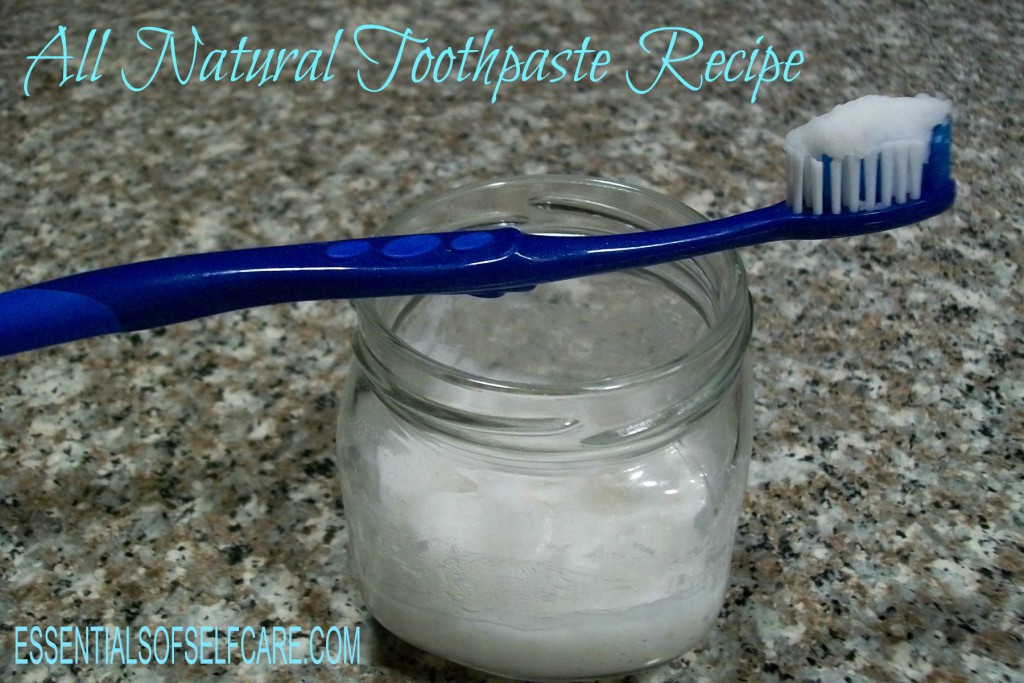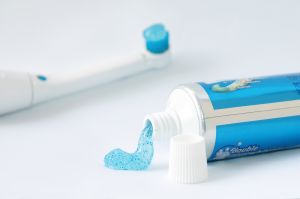Toothpaste is something we use on a daily basis and the fact is, no matter how hard we try not to, some of it always gets ingested. So awhile back, when I decided to ditch the nasties, making the switch to all natural toothpaste was one of the first things I did.

This all natural toothpaste recipe is a super simple way to use ingredients you may already have at your disposal, or are usually readily available at natural foods markets. Ingesting even a tiny amount of your average major brand toothpastes can be harmful, especially to children.
Maybe you’re already aware of the hazards of certain ingredients, but as I started doing more research something else really interesting caught my attention…toothpaste may not even be all that necessary to dental health in the first place, in fact it may not really do a thing at all!
What if Toothpaste Just Covers Up Bad Breath?
Many dentists, and dental hygienists claim that after many years of looking at millions of peoples mouths day after day they’ve realized that toothpaste is merely a “cosmetic” product that we are shown in commercials to use a lot of to have healthier gums, whiter teeth, and fresher breath. And naturally, who doesn’t want that, right?
For an interesting read on this topic written by a dental hygienist, click here.
What I’m gathering is that the way we brush, in other words, the method, including time spent and tools we use to clean our teeth and gums with give us more protection against gum disease than anything else really. Not so shocking, I suppose.
That being said, I do enjoy my toothpaste and therefore will continue to use it :)
Also, there have been many benefits expressed regarding the re-mineralization effects a natural toothpaste has along with a healthy diet rich in raw dairy, healthy fats, cod liver oil (fat soluble foods containing high vitamin D) researched by dentist Weston A. Price as part of primitive diets that prevented tooth decay.
Toothpaste Ingredients to Avoid
Flouride. This one is becoming more and more of a no brainer, thanks to a building awareness regarding the detrimental effects it can have on the brain, lessening cognitive function and even lowering IQ in children. It has also been linked to bone cancers, gastrointestinal upset, thyroid and pineal gland issues.
The risk of exposure is increased with dental treatments (i.e. routine cleanings, drinking water from the tap and the levels absorbed through our skin when showering or bathing). Since dental products and water are two common sources of flouride, we avoid it, opting for a drinking water filtration system that removes flouride along wiht the usual contaminants, and using a water filters in the shower.
Glycerin. This ingredient can contribute to de-mineralization, stripping teeth of the necessary minerals that keep them strong and prevent decay, and prevent the re-mineralization needed to prevent further tooth decay.
Sodium Lauryl Sulfate. I’ve mentioned the concerns with this synthetic ingredient in skin care products. It’s a popular foaming agent that is a known hormone disruptor, carcinogenic, and can cause skin and eye irritations, particularly used in the mouth it has been known to cause canker sores or mouth ulcers.
Aspartame, Sorbitol, and other artificial sweeteners. These types of sweeteners cause a slew of health issues such as headaches, dizziness, nausea, blurred vision, mood changes, depression, memory loss, seizures, abdominal cramping, fatigue, joint pain, numbness, fibromyalgia, systemic lupus, multiple sclerosis, and a variety of cancers. Learn more here.
FD&C Blue Dye No. 2. Frequently used in many commercial toothpastes, along with other colors. Most of us are aware of the dangers linked to dyes such as behavioral issues, and cognitive impairment.

Triclosan. A well known and widely used antibacterial when mixed with chlorine (which is in most tap water) forms chloroform. So every time you brush your teeth with tap water and chemical toothpaste it creates a highly toxic soup right in your mouth, some of which gets swallowed.
Polyethylene. This one is super scary! These are those tiny little blue beads you find in tons of toothpastes, Crest brand is particularly is big on them. What it actually is though, is a type of plastic that is virtually indestructible and definitely not at all biodegradable.
Read here about how a dental hygienist continues to find these embedded in patients gums, the problems they are causing in creating more entry ways for bacteria to reach the gums, actual images that show just how toxic this stuff is and what Crest is aiming to do about it.
We’re talking a major commercial toothpaste brand here…yikes!
So now on to the good stuff! A super simple, safe and effective way to keep those pearly whites smiling for the entire family that you can throw together in a matter of minutes!
All Natural Toothpaste Recipe
INGREDIENTS
- 2 Tbsp coconut oil
- 4 Tbsp baking soda
- 1/2 tsp fine sea salt
- 10-15 drops liquid minerals (We use these as a supplement too)
- 40 drops food grade peppermint essential oil
- Optional: stevia or xylitol to taste
DIRECTIONS
- Add softened coconut oil to a glass container, it should be easy enough the stir
- Add baking powder and mix well
- Add sea salt and mix well
- Add liquid minerals and essential oil and combine
- Give it a test drive (I brushed my teeth with it now) to see if you want to add sweetener
- Add your optional stevia OR xylitol (start with a very small amount) give a stir and continue to adjust until you’re satisfied with your finished product
- Store your toothpaste in your bathroom and when ready to use just dip your toothbrush in (if you’re not concerned with cooties), barely wet and brush away :)
Note: This recipe is easy to adjust. If you want thicker toothpaste, add a bit more baking soda. If you want a more liquid texture add a little purified water to thin it out. You can add more or less essential oil, or different flavors (just make sure your oils are also for internal use, not external only) like cinnamon, orange, clove, or lemon.
Also note that the baking soda in this recipe is great for whitening your teeth but is mildly abrasive. For a non-abrasive alternative, and my favorite to use on a regular basis, you might like my clay based DIY toothpaste here. And if teeth whitening is what you’re after, you can learn how activated charcoal can be used naturally to help brighten your pearly whites.
I hope you enjoy your homemade toothpaste! If you try it, let us know what you thought in the comments below!
